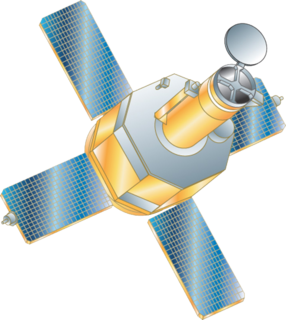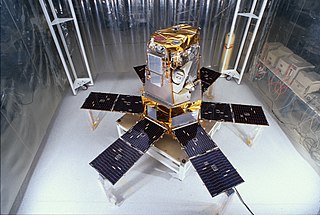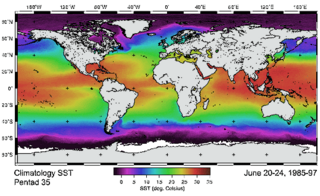
Ultraviolet (UV) is a form of electromagnetic radiation with wavelength from 10 nm to 400 nm, shorter than that of visible light, but longer than X-rays. UV radiation is present in sunlight, and constitutes about 10% of the total electromagnetic radiation output from the Sun. It is also produced by electric arcs and specialized lights, such as mercury-vapor lamps, tanning lamps, and black lights. Although long-wavelength ultraviolet is not considered an ionizing radiation because its photons lack the energy to ionize atoms, it can cause chemical reactions and causes many substances to glow or fluoresce. Consequently, the chemical and biological effects of UV are greater than simple heating effects, and many practical applications of UV radiation derive from its interactions with organic molecules.

Clementine was a joint space project between the Ballistic Missile Defense Organization and NASA, launched on January 25, 1994. Its objective was to test sensors and spacecraft components in long-term exposure to space and to make scientific observations of both the Moon and the near-Earth asteroid 1620 Geographos.

The Geostationary Earth Radiation Budget (GERB) is an instrument aboard EUMETSAT's Meteosat Second Generation geostationary satellites designed to make accurate measurements of the Earth Radiation Budget.
A pyranometer is a type of actinometer used for measuring solar irradiance on a planar surface and it is designed to measure the solar radiation flux density (W/m2) from the hemisphere above within a wavelength range 0.3 μm to 3 μm. The name pyranometer stems from the Greek words πῦρ (pyr), meaning "fire", and ἄνω (ano), meaning "above, sky".
A spectroradiometer is a light measurement tool that is able to measure both the wavelength and amplitude of the light emitted from a light source. Spectrometers discriminate the wavelength based on the position the light hits at the detector array allowing the full spectrum to be obtained with a single acquisition. Most spectrometers have a base measurement of counts which is the un-calibrated reading and is thus impacted by the sensitivity of the detector to each wavelength. By applying a calibration, the spectrometer is then able to provide measurements of spectral irradiance, spectral radiance and/or spectral flux. This data is also then used with built in or PC software and numerous algorithms to provide readings or Irradiance (W/cm2), Illuminance, Radiance (W/sr), Luminance (cd), Flux, Chromaticity, Color Temperature, Peak and Dominant Wavelength. Some more complex spectrometer software packages also allow calculation of PAR μmol/m2/s, Metamerism, and candela calculations based on distance and include features like 2- and 20-degree observer, baseline overlay comparisons, transmission and reflectance.

Transition Region and Coronal Explorer was a NASA heliophysics and solar observatory designed to investigate the connections between fine-scale magnetic fields and the associated plasma structures on the Sun by providing high resolution images and observation of the solar photosphere, the transition region, and the solar corona. A main focus of the TRACE instrument is the fine structure of coronal loops low in the solar atmosphere. TRACE is the third spacecraft in the Small Explorer program, launched on 2 April 1998, and obtained its last science image on 21 June 2010, at 23:56 UTC.

The Solar Radiation and Climate Experiment (SORCE) was a NASA-sponsored satellite mission that measured incoming X-ray, ultraviolet, visible, near-infrared, and total solar radiation. These measurements specifically addressed long-term climate change, natural variability, atmospheric ozone, and UV-B radiation, enhancing climate prediction. These measurements are critical to studies of the Sun, its effect on our Earth system, and its influence on humankind. SORCE was launched on 25 January 2003 on a Pegasus XL launch vehicle to provide NASA's Earth Science Enterprise (ESE) with precise measurements of solar radiation.
The Tel Aviv University Ultraviolet Explorer, or TAUVEX, is a space telescope array conceived by Noah Brosch of Tel Aviv University and designed and constructed in Israel for Tel Aviv University by El-Op, Electro-Optical Industries, Ltd. acting as Prime Contractor, for the exploration of the ultraviolet (UV) sky. TAUVEX was selected in 1988 by the Israel Space Agency (ISA) as its first priority scientific payload. Although originally slated to fly on a national Israeli satellite of the Ofeq series, TAUVEX was shifted in 1991 to fly as part of a Spektr-RG international observatory, a collaboration of many countries with the Soviet Union leading.

The Advanced Very-High-Resolution Radiometer (AVHRR) instrument is a space-borne sensor that measure the reflectance of the Earth in five spectral bands that are relatively wide by today's standards. AVHRR instruments are or have been carried by the National Oceanic and Atmospheric Administration (NOAA) family of polar orbiting platforms (POES) and European MetOp satellites. The instrument scans several channels; two are centered on the red (0.6 micrometres) and near-infrared (0.9 micrometres) regions, a third one is located around 3.5 micrometres, and another two the thermal radiation emitted by the planet, around 11 and 12 micrometres.

The Cosmic Origins Spectrograph (COS) is a science instrument that was installed on the Hubble Space Telescope during Servicing Mission 4 (STS-125) in May 2009. It is designed for ultraviolet (90–320 nm) spectroscopy of faint point sources with a resolving power of ≈1,550–24,000. Science goals include the study of the origins of large scale structure in the universe, the formation and evolution of galaxies, and the origin of stellar and planetary systems and the cold interstellar medium. COS was developed and built by the Center for Astrophysics and Space Astronomy (CASA-ARL) at the University of Colorado at Boulder and the Ball Aerospace and Technologies Corporation in Boulder, Colorado.

The Extreme Ultraviolet Explorer was a NASA for ultraviolet astronomy. EUVE was a part of NASA's Explorer spacecraft series. Launched on 7 June 1992. With instruments for ultraviolet (UV) radiation between wavelengths of 7 and 76 nm, the EUVE was the first satellite mission especially for the short-wave ultraviolet range. The satellite compiled an all-sky survey of 801 astronomical targets before being decommissioned on 31 January 2001.

Astrosat is India's first dedicated multi-wavelength space telescope. It was launched on a PSLV-XL on 28 September 2015. With the success of this satellite, ISRO has proposed launching AstroSat-2 as a successor for Astrosat.

PROBA-2 is the second satellite in the European Space Agency's series of PROBA low-cost satellites that are being used to validate new spacecraft technologies while also carrying scientific instruments. PROBA-2 is a small satellite (130 kg) developed under an ESA General Support Technology Program (GSTP) contract by a Belgian consortium led by Verhaert of Kruibeke, Belgium. The nominal mission duration was two years. As of 2019, the mission continues.
NOAA-13, also known as NOAA-I before launch, was an American weather satellite operated by the National Oceanic and Atmospheric Administration (NOAA). NOAA-I continued the operational, polar orbiting, meteorological satellite series operated by the National Environmental Satellite System (NESS) of the National Oceanic and Atmospheric Administration (NOAA). NOAA-I continued the series (fifth) of Advanced TIROS-N (ATN) spacecraft begun with the launch of NOAA-8 (NOAA-E) in 1983. NOAA-I was in an afternoon equator-crossing orbit and was intended to replace the NOAA-11 (NOAA-H) as the prime afternoon (14:00) spacecraft.

Proba-3 is a technological demonstration mission by the European Space Agency devoted to high precision formation flying to achieve scientific coronagraphy. It is part of the series of PROBA satellites that are being used to validate new spacecraft technologies and concepts while also carrying scientific instruments.

Liège Space Center is a research center of the University of Liège in Belgium. It holds a hundred people, half of whom are engineers and scientists. The activities of the CSL are specialized in optics, space technologies and space environment testing.
Lunar Ultraviolet Cosmic Imager (LUCI) is a small planned telescope that will be landed on the Moon to scan the sky in near UV wavelengths. It is a technology demonstrator developed by the Indian Institute of Astrophysics, and it was planned to be one of several small payloads to be deployed by the commercial Z-01 lander developed by TeamIndus in partnership with OrbitBeyond. The mission was planned to be launched in 2020 as part of NASA's Commercial Lunar Payload Services (CLPS). On 29 July 2019 OrbitBeyond announced that it will drop out of the CLPS contract with NASA, meaning that the 2020 launch was canceled and it is unknown whether the mission will ever take place.

NOAA-9, known as NOAA-F before launch, was an American weather satellite operated by the National Oceanic and Atmospheric Administration (NOAA) for use in the National Environmental Satellite Data and Information Service (NESDIS). It was the second of the Advanced TIROS-N series of satellites. The satellite design provided an economical and stable Sun-synchronous platform for advanced operational instruments to measure the atmosphere of Earth, its surface and cloud cover, and the near-space environment.
NOAA-10, known as NOAA-G before launch, was an American weather satellite operated by the National Oceanic and Atmospheric Administration (NOAA) for use in the National Environmental Satellite Data and Information Service (NESDIS). It was the third of the Advanced TIROS-N series of satellites. The satellite design provided an economical and stable Sun-synchronous platform for advanced operational instruments to measure the atmosphere of Earth, its surface and cloud cover, and the near-space environment.
Solar-blind technology is a set of technologies to produce images without interference from the Sun. This is done by using wavelengths of ultraviolet light that are totally absorbed by the ozone layer, yet are transmitted in the Earth's atmosphere. Wavelengths from 240 to 280 nm are completely absorbed by the ozone layer. Elements of this technology are ultraviolet light sources, ultraviolet image detectors, and filters that only transmit the range of wavelengths that are blocked by ozone. A system will also have a signal processing system, and a way to display the results (image).












